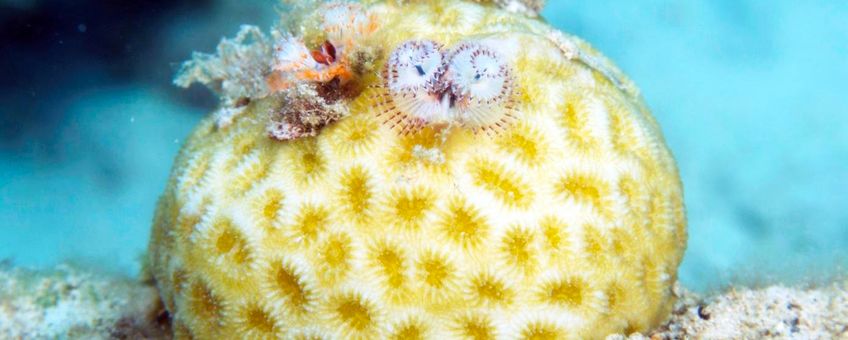
New discoveries on relationships between host corals, crabs and christmas tree worms
Dutch Caribbean Nature Alliance (DCNA), Naturalis Biodiversity CenterMany marine species depend on corals for food, substrate and shelter. Each coral species may act as host for particular species of fish, crabs, shrimps, snails, worms, or other kinds of invertebrates. In a time when coral species are becoming increasingly threatened with extinction, it is even more important to take inventory of their associated fauna. Many marine species live within crevices of the coral skeleton while others hide underneath or in between corals. Some species are easy to spot because of their bright colours or their sudden movements, while others remain quiet and well hidden. To understand these associations and the ecological role of coral species in coral reef biodiversity, scientists need to study each coral in a systematic way. It is important that researchers are able to not only identify each species of coral, but understand any relationships to species they host. 
Recently, a team of researchers from Naturalis Biodiversity Center, ANEMOON Foundation, and colleagues from various institutes, performed several biodiversity surveys in the Dutch Caribbean (Bonaire, Curaçao, Sint Eustatius). These expeditions were organized by professor Bert Hoeksema, who is the coral expert at Naturalis and honorary professor of tropical marine biodiversity at the University of Groningen. The team discovered, amongst others, some new associations for Christmas tree worms (Spirobranchus spp.) as symbionts within different coral species. These worms live partly inside the host coral and appeared to be able survive when it becomes covered by encrusting animals, who then serve as a secondary host. Surprisingly, most discoveries were made in very shallow water (less than two meters depth), where scuba divers may spend less time compared to greater depths.
Scientists also looked at how associated fauna may affect the morphology and the condition of the host corals. Some species of coral, again in very shallow water, appeared to host crabs that make large cavities inside the coral skeleton. The same crab species (Domecia acanthophora) appeared to make different types of holes within elkhorn coral, Acropora palmata, than in the fire coral Millepora complanata. These host coral species are not closely related, which makes one wonder how the host selection of these crabs has evolved.

Both stories were published as separate articles in the online (open access) journal Diversity.
- Hoeksema, B.W.; García-Hernández, J.E.; van Moorsel, G.W.; Olthof, G.; ten Hove, H.A. Extension of the Recorded Host Range of Caribbean Christmas Tree Worms (Spirobranchus spp.) with Two Scleractinians, a Zoantharian, and an Ascidian. Diversity 2020, 12, 115
- Hoeksema, B.W.; García-Hernández, J.E. Host-related Morphological Variation of Dwellings Inhabited by the Crab Domecia acanthophora in the Corals Acropora palmata and Millepora complanata (Southern Caribbean). Diversity 2020, 12, 143.
Text:Tineke van Bussel, Jessica Johnson, Dutch Caribbean Nature Alliance en Bert Hoeksema, Naturalis Biodiversity Center.
Pictures: Bert W. Hoeksema, Naturalis Biodiversity Center and Rijksuniversiteit Groningen; Jaaziel E. García-Hernández, University of Puerto Rico - Mayagüez
